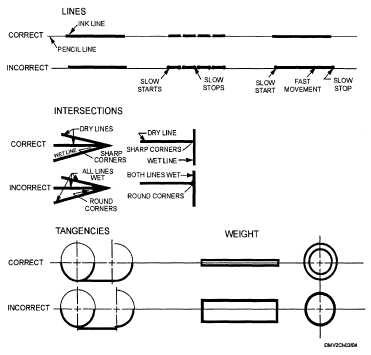Drafting Techniques, Continued
Inking
techniques
When inking or tracing over pencil lines, center the ink line over the pencil
line. If done correctly, the line thickness will overlap at points of tangency
producing a smooth transition from straight to curved lines. When drawing
intersecting lines, allow previous ink lines to dry before drawing the
intersecting lines to prevent teardrop-shaped ends and rounded corners. If
the drawing paper is excessively dirty or the pencil lead has a wax-based
resin, ink may crawl producing ragged edges. Papers may absorb hand oils
with excessive handling. Use a slip sheet of clean white paper under your
hands to protect the paper surface. Factors that make lines heavier include
slow movement of the pen, caked particles of ink in the reservoir, leaning the
pen in any direction (not maintain perpendicularity), or a soft or humidity-
affected working surface. Lines may become finer under the following
conditions: rapid movement of the pen, an insufficient amount of ink in the
reservoir, fresh ink in a clean pen, holding the pen perpendicular to the paper
surface, or a hard or high paper surface.
Figure 3-4 illustrates correct and incorrect inking techniques.
Figure 3-4.—Inking techniques.
Continued on next page
3-9

